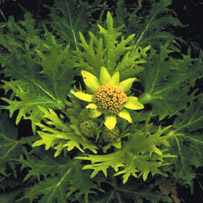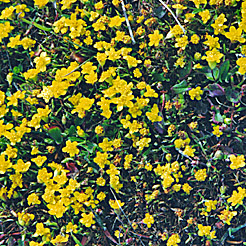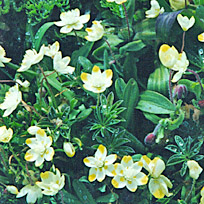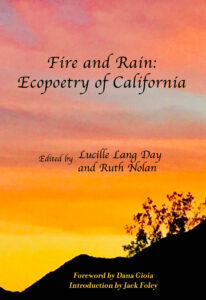Posts Tagged ‘wildflowers’
The way we learn to belong
Once more we are at that seasonal turn familiar in California history: after a winter of great rains, floods and mudslides, the promise of an extraordinary blaze of color as wildflowers burst into bloom. My first experience of this magical transition was in 1969, my second spring in this new country. I describe it in letters to parents:
Feb. 28, 1969
It has actually stopped raining for the past hour. Another shower on the way, of course, but such a respite to see the sun. We have been averaging one sunny day a week for the past two months, and the general situation is already critical. We are not doing too badly in the Santa Clara Valley. All the creeks are contained by reservoirs up in the hills, and although the largest one, Anderson, is spilling over the top and flooding parts of east-side San José, the others are still holding their own. Fortunately the weather-man had predicted a respite for the next four or five days, i.e., drizzle instead of a deluge, and the authorities are hoping to get enough water away through the sluices of the other six dams during this time to make room for next week’s storms. Where we live is on relatively high ground anyway, so it is unlikely that we would be affected. The really big headache though is Central Valley, which drains the whole of the Sierra Nevada range. The Sacramento-San Joachim delta has flooded twice already in the past two months, and the river levels are still dangerously high. But in the high Sierra the snow fall is already twice the annual average, and we are only one third through the rainy season. Sooner or later that stuff is going to thaw, and if there is a warm rain up there, the effect will be sudden and disastrous. Meanwhile, it is still raining, with violent storms rolling in from the Pacific with tedious regularity. For some vast meteorological reason, the storm belt has swung further south than normal this year—so we are getting what Alaska usually gets. (They say it’s a mild winter in Alaska this year!)
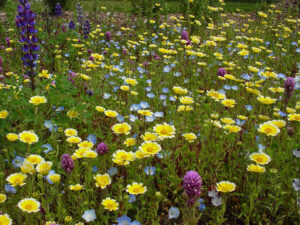
A field of mixed wildflowers: Arroyo Lupine, Baby Blue-eyes, Purple Owls Clover and Tidy-tips. Image from Mother Nature’s Backyard.
And a few weeks later:
April 14, 1969
[After a visit to the Lick Observatory on Mt. Hamilton] We decided to see what it was like on the other side of the mountain. We found ourselves in a charming little valley, the San Antonio, which we followed back to Livermore and the freeway home. The land in this part is lightly wooded, and very sparsely populated—we saw a few ranch houses, occasional small herds of cattle, the odd horseman and dog, and that’s all. And at this time of year, the earth between the trees is covered with fresh grass, so scattered and strewn with wildflowers that it looks like some magic carpet.
I think it is one of the most wonderful sights I have ever seen. Great swathes of colour, of every shade. One they call Sunshine, or Goldfields, a tiny daisy-like flower, brilliant yellow. It grows only a few inches high, but in such profusion that, as its name implies, it makes a great field of colour. And on the slopes of Mt. Hamilton we thought for a while the snow was still lying, there were such patches of a snowy white flower. But other colours too, pinks and blues right through to the purples and reds. And down in the lower valleys, the California poppy, a brilliant orange. …I love these flowers so much.
An interviewer recently asked me what moved me toward writing about nature. I replied that as an immigrant, learning about the land was a big part of learning to belong to my adopted country. I’ve found this be particularly true when I moved from the Bay Area to the Mendocino coast. I’ll always be grateful to Dr. Teresa Sholars, whose College of the Redwoods wildflower identification class gave me the names of beloved beauties. Here’s a poem about them:
California Wildflowers
It seems a simple joy
to greet the flowers by name
Tidy Tips, Goldfields, Blue-Eyed Grass,
Crane’s Bill and Cream Cup,
Sticky Monkey Flower,
Mule’s Ears, Owl’s Clover,
Sun Cups glossy by the path,
Milkmaids in shade,
Lupine and Poppy on the slope,
but to the immigrant who after 40 years
still speaks with foreign intonation,
these are pet-names for familiars
precious as friends,
who speak in a language without words
of soils: clay and serpentine,
of rains and drought,
the way the lineaments of the land
impress themselves,
the way we learn to belong.
In a couple of days I’m off to Portland, OR for the Associated Writing Programs (AWP) conference. I was invited to be part of a group representing Scarlet Tanager Books, publisher of the anthology Fire & Rain: Ecopoetry of California, in which I have several poems. We’re hosting a reception at the conference, and doing a reading at a neighboring bookstore. Being recognized as an “ecopoet of California” makes me feel that, after what is now 52 years, this beautiful state is home. Enjoy this season’s flowers.
Blennosperma
In this unseasonably gorgeous January weather, I started thinking about wildflowers. This morning I took a walk at Glass Beach to look for Blennosperma. Sure enough, they’re up. Not yet the carpet of gold, but a few bright yellow stars dot the green of our coastal prairie, the uplifted strip of land at the edge of the cliffs. Like many of the California wildflowers we amateur flower seekers call “little yellow jobs,” the Blennosperma flower is daisy-like and shiny. Our variety, Blennosperma nanum var. robustum, is on the Endangered Species list. It grows only on the Glass Beach Headlands and at Point Reyes.
Glass Beach, now part of MacKerricher State Park, is a popular place to walk. There is talk of putting a cycling trail through it. Seeing those early flowers, I realize again that we’re in danger of loving this place to death. I try to be careful where I walk.
Where the flowers are
It is one thing to know as a fact that high rainfall tallies in California’s rainy season result in more spring wildflowers. It is quite another thing to feel with your whole being that exuberant burst of fecundity.
At MacKerricher State Park this morning the air is misty and the sea is calm. Out by Laguna Point, swathes of Goldfields (Lasthenia chrysotoma) dazzle the eye. Up close, I see that among the Goldfields are patches of Purple Butter & Eggs (Triphysaria eriantha ssp. rosea) whose complementary color makes the gold even more eye-popping. Scattered among them are California Poppies (Eschscholzia californica). Not the orange poppies we coast dwellers snobbishly refer to as freeway poppies, but our own coastal variety, the leaves more fleshy to resist the salt wind, the flowers a prettier yellow.
South along the headlands trail, I know a place where Coast Delphinium (Delphinium decorum) grows. Never more than a foot high, each plant has a head of deep blue flowers that glow with intensity. This year they are magnificent. As I crouch to admire, I remember renewing their acquaintance in previous springs.
This is the way an immigrant learns to belong: to come back and back to a place, to remember its varied moods, to remember where the flowers are.
Joyful for Salamanders
A Sunday afternoon walk with friends up Fern Canyon in Van Damme State Park. The creek is running fast and high, the trail is squelchy. Signs of early spring growth: stream violets, trilliums and redwood sorrel in flower, green tips to the elderberry and salmonberry. Downed wood from last week’s storm.
Wendy and I, who have lagged behind, notice a young woman squatting by a log at the side of the trail. She rolls it over.
“Found anything interesting?” Wendy asks.
“Salamanders,” says a young man at my elbow. “Six different species so far.” He holds out a cupped hand. “Ensatina eschsoltzi.” His voice floods with love for the bulbous creature on his palm, shiny gray-brown above, with pale orange underparts.
“Here’s a lovely big Slender,” calls a girl at another chunk of log. Everyone crowds around to admire her tightly curled prize.
The quartet of young people are biology students from UC Davis. “Only I had to stop out,” says the young man. “Funding ran out. But I’ll be back by summer.”
The Fern Canyon trail is blocked a mile or two up by downed trees not yet cleared. The trailhead restrooms are closed for lack of state funding. We could feel discouraged and depressed about California’s economic chaos. But the enthusiasm of these young people we met, their joy in their quest for knowledge, gives reason for hope.
Spring Slinks In
Here on the Mendocino Coast, where winters are mild and rainy, now is the time to look for the first wildflower, Scoliopus bigelovii, commonly known as Slink Pod. The shady bank down by our creek, where I usually see them, was littered today with debris where the top of an old fir had fallen, but there was still one plant unsmushed by the crash, a new bud opening, and spent flower heads already slinking off to find new earth for their seeds.
